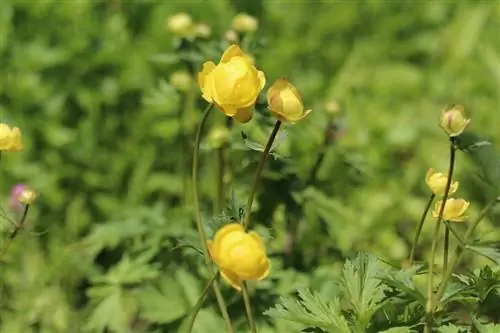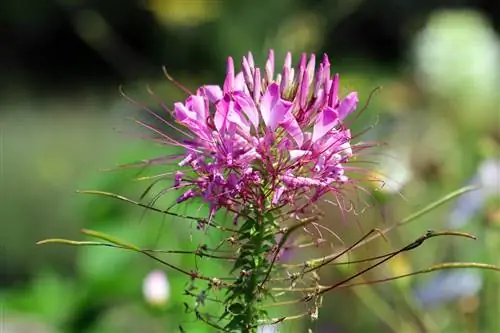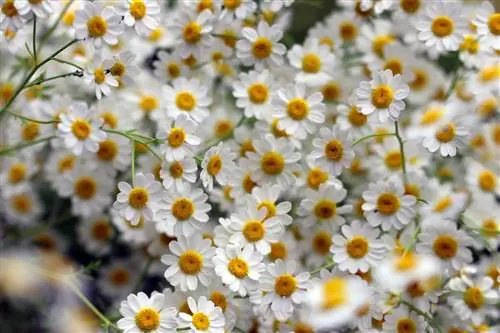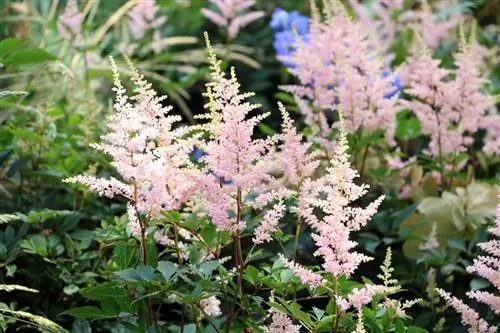- Author admin [email protected].
- Public 2023-12-17 03:39.
- Last modified 2025-01-24 12:45.
The initially spherical flowers of this yellow-flowering perennial have immense luminosity. It is rarely found in the wild anymore, which is due to the fact that its natural habitats are increasingly disappearing.
Profile
- Plant family: Buttercup family (Ranunculaceae)
- Botanical name: Trollius
- German names: globe flower, goldhead, buttercup, butter rose
- Growth: persistent, herbaceous, clump-forming
- Growth height: 20-60 cm
- Leaves: green, pinnate, dull, coarse, leaf edge roughly sawn, shedding leaves
- Flowering period: May to June/July
- Flower: yellow or orange, simple, spherical, later cup-shaped
- Fruits: Collected follicles consisting of many beaked follicles
- Toxicity: poisonous
- Lime tolerance: tolerates lime-poor soils
Location requirements
In nature, the troll flower (Trollius) is preferably found in ditches, on river banks, on moderately fertilized wet meadows and in moors, where water and nutrients collect. As a result, it ideally wants to be in partial shade in open, damp and airy places in the garden.
- Goldhead needs a location with enough light
- but should be protected from strong sunlight
- especially during lunchtime
- is particularly suitable for natural planting
- on pond banks, streams, other bodies of water or wet spots in the garden
- also suitable for perennial borders, provided the soil conditions are right
- basically prefers damp to swampy locations
- with poorly permeable, humus-rich and nutrient-rich soils
- Goldheads completely unsuitable for dry locations
- as well as for underplanting trees
- does not tolerate root pressure from larger plants
Tip:
Good companion plants for this pretty perennial include cranesbill, hosta, swamp forget-me-not, carnation root, ziest, iris and bleeding heart.
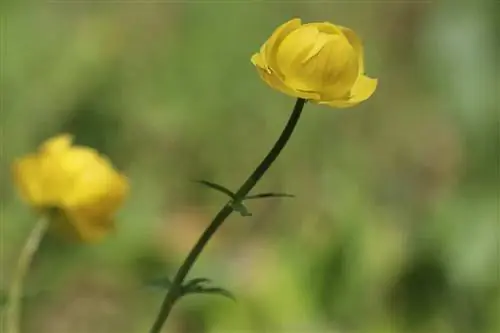
Planting
The best time to plant is in spring. You create appropriately sized planting holes and plant the plants. If necessary, you can enrich the soil with some compost. The buttercup forms a wide and dense root system that reaches a depth of up to 40 cm. Accordingly, their space requirements are. There are around seven to nine plants per square meter. Planting distances of approx. 30 cm are recommended. This perennial looks particularly beautiful when planted in groups, as it is particularly bright.
Tip:
Since the globeflower is now a protected species and is also one of the most important sources of nutrients for bees, planting it in the garden is definitely recommended.
Care instructions
The care requirements for this perennial depend primarily on the location. Since it is constantly dependent on moisture, care in sunny locations is much more complex than in partially shaded and moist places. Under optimal conditions, this plant is very robust and easy to care for.
Pouring
Trollflowers require a constantly moist soil level from spring to autumn. Even short periods of flooding are not a problem for them. In the first few days after planting, water should be extensive, provided the perennial is not directly next to water. Water requirements are particularly high in very dry summers. Accordingly, the need must then be met from outside. In general, the sunnier the plant is, the more often it should be watered.
Fertilize
In addition to a moist and partially shaded location, the buttercup needs a humus-rich environment with sufficient nutrients. Therefore, it should be fertilized from time to time. It is best to apply a commercially available complete fertilizer or compost in the spring before flowering. This means the plants are well supplied with nutrients over a longer period of time. If no compost is available, a phosphorus-rich blooming fertilizer is also suitable.
Cutting
During flowering, wilted flowers should be cut off regularly. This stimulates the formation of new flowers and can lead to repeat blooms. Once flowering is complete, the plants can be cut back close to the ground. As a rule, it is not absolutely necessary to cut close to the ground, as the globeflower will move in in the fall anyway. After pruning, it is recommended to fertilize again, e.g. B. with compost.
Wintering
Thanks to its European origin, the buttercup is also hardy in our latitudes. The above-ground parts of the plant freeze back to ground level in winter. Usually a small stalk remains from which the plant will sprout again the next year. The root survives in the ground and also sprouts again. If extreme frost threatens, it is advisable to cover the root area with fleece, brushwood, leaves or a layer of mulch. No further protective measures are necessary.
Propagate
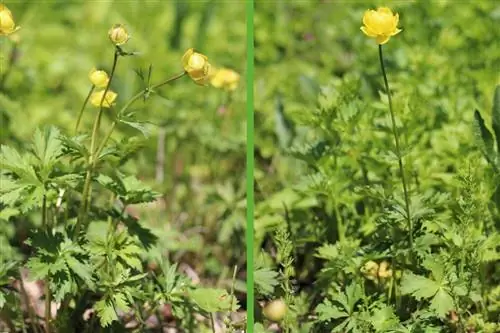
Sowing
If you leave a few flowers on the plant in autumn, fruiting bodies will form and then ripen. When the fruits are ripe, they dry up and open and the plant sows itself. The seeds rest in the ground over the winter and then sprout again in the spring. If you want to do it yourself and propagate the plant by sowing, you should do that from autumn onwards.
The seeds of Trollius are among the so-called cold germinators. Because of this, they do not have to be grown indoors, but can be sown directly on site from October to December. They are subjected to a natural cold treatment for several weeks, which they need to germinate. If the seedlings are large and strong enough, they can be separated. However, the seeds germinate relatively poorly, so the result is not always satisfactory.
Tip:
It can take about two years for this plant to bloom for the first time.
Division
Division promises much more success. This not only serves to propagate this long-lasting perennial, but also to rejuvenate it. Division also has the advantage that you can get pure plants from it. The best time for this is early spring.
- First division after ten years at the earliest
- in spring when budding begins or after flowering
- dig up the entire rootstock
- with spade or digging fork
- If necessary, loosen the soil around the roots a little
- Cut the bale into several pieces with your hands or a sharp knife
- each section should have sufficient roots
- Replant newly acquired plants
- water everything thoroughly
Diseases
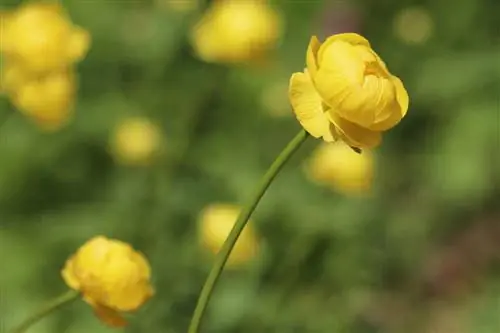
Powdery mildew
Even if the buttercup is relatively rarely affected by diseases, powdery mildew can occasionally occur. The cause is often unfavorable location conditions or deficiency symptoms as a result of improper care. Powdery mildew appears as a mealy coating on the tops of the leaves. Later it covers the entire plant. Early treatment is most promising. This means that all affected parts of the plant should first be cut off and disposed of with household waste.
If the plant grows in autumn, it is advisable to cut it down close to the ground. A small infestation can possibly be managed with various home remedies. If it is already well advanced, you cannot avoid using appropriate fungicides.
Tip:
To prevent an infestation, spray with field horsetail broth in spring.
Leaf spot disease
Leaf spot disease can also be the result of deficiency symptoms. Signs of this disease include brown, red, or yellowish spots on the leaves. Here, too, it is important to remove infected plant parts as quickly as possible, as well as any parts of the plant that are on the ground. Treat with a suitable broad-spectrum fungicide from a specialist retailer and, if necessary, repeatedly. If the infestation is too severe, it is advisable to completely remove and dispose of the affected plant.
Caution poisonous
The troll flower (Trollius) is considered slightly poisonous. The toxicity corresponds to that of buttercup plants, to which this perennial is related. The toxic effect is based on the alkaloid magnoflorin. As a rule, symptoms of poisoning can only be expected if large quantities are consumed. Smaller children who like to put things in their mouths are particularly at risk.
After consuming the fresh herb, stomach and intestinal problems, diarrhea, burning of the oral mucous membranes and general pain can occur. In severe cases, dizziness, shortness of breath and severe cramps may occur. External skin irritations, including blisters and swelling, are possible for sensitive people. Allergy sufferers in particular can show symptoms such as a runny nose and burning eyes.
Tip:
If there is evidence of poisoning, especially in children, you should consult a doctor or call the poison control center as quickly as possible.

